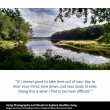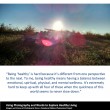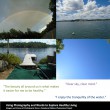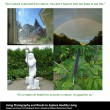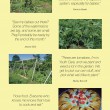Give people cameras and they’ll show you what they see.
Members of the Little Earth of United Tribes urban Indian community in Minnesota and the Penobscot Nation in Maine were recently given the chance to do just that through a photovoice project organized by the Geisel School of Medicine at Dartmouth and funded by a grant from the Aetna Foundation. Participants photographed what they saw as challenges to healthy eating and an active lifestyle in their respective communities.
“Through our grantmaking across the country, we’ve learned that the best solutions to health inequities will combine the insights of the communities themselves with proven, best-practice approaches,” said Alyse Sabina, MPH, National Program Director. “We’re proud to be a part of this innovative step toward improving health in Native American communities.”
Photovoice is an innovative method that empowers participants to frame potential solutions to social and environmental health challenges through photography and group discussion. With a generous grant from the Aetna Foundation, a team at Geisel’s Center for Health Equity used photovoice to gain a better understanding of health within these two distinct Native American communities—one urban and one rural—directly from the people who live there. In addition, the Center for Native American Youth at the Aspen Institute will share the findings of this project through its programs, national meetings, and social media.
“Photovoice helps people to have a voice,” says Anna Adachi-Mejia, PhD, Deputy Director of the Health Promotion Research Center at Dartmouth and one of the key collaborators on the project.
“This project is well aligned with the Center for Health Equity’s mission to work in partnerships to promote health among underserved populations in local and global environments,” says Adams, director of the Center and the leader of the project.
“Health has to be understood broadly to include cultural and social determinants of health,” says Susen Fagrelius, Little Earth Community Health Initiative Coordinator. “The tribal world view is holistic and relational. The photovoice posters demonstrate that.” Several of the posters reference the importance of nature to mental, physical, and spiritual health.
To achieve the broad objective of better understanding community wellness at these two communities, Adachi-Mejia trained interns selected from Dartmouth College and the Geisel School to implement the photovoice methodology.
“The project started with building trust and relationships with communities,” says Shawn O'Leary, the Director of Multicultural Affairs at Geisel. Dartmouth has on-going relationships with Little Earth, beginning in 2010, and the Penobscot Nation, beginning in 2000.
O’Leary, a member of the Bois Forte, Minnesota, Band of Chippewa, worked with the interns before their project to help them better understand the culture of the two communities.
In addition, tribal and community leaders served as liaisons, helping the Dartmouth interns recruit participants.
“The interns were amazing,” says Fagrelius. “They worked with Little Earth residents in such fun, uplifting, and compassionate ways—using every ounce of creativity and ingenuity they had, day after day.”
The interns trained participants to use the cameras, led group discussions about what constitutes barriers or gateways to healthy eating and active lifestyles, and sent participants out to capture images of their ideas. Participants worked collaboratively creating posters that incorporated their images and words to illustrate their discoveries.
In the Penobscot Nation in Maine, several participants photographed the river that surrounds their island home, naming it as the key to the community’s overall health. Water pollution and dams on the river form both physical and spiritual barriers to community health: Poor water quality has depleted fish, and dams inhibit water travel, which is essential to traditional hunting. Many of the photographs taken in Maine illustrate the link between participants’ spiritual and physical health and the health of the river.
Little Earth is an urban community. One of the posters from that community captures the unhealthy but inexpensive food at the local convenience store juxtaposed with the more expensive fresh vegetables at the distant supermarket. A third photo shows the community garden called Little Earth Urban Farm, which promotes both healthy food and the healthy outdoor activity of gardening. Another poster includes a photo of tobacco seedlings next to a cigarette to illustrate how keeping tobacco sacred by growing it for ceremonial use is healthier than smoking more harmful, habit-forming, chemically laden cigarettes.
The photovoice project culminated in community-wide celebrations at each location, where these posters were displayed. Adachi-Mejia likened these events to graduation commencement. With their new skills, participants can now begin to use photovoice to articulate their problems and communicate their needs with powerful clarity. Already, they have shown the Dartmouth interns the importance of a holistic approach to health.
